人教版七年级上册英语知识点归纳
- 格式:docx
- 大小:115.28 KB
- 文档页数:28
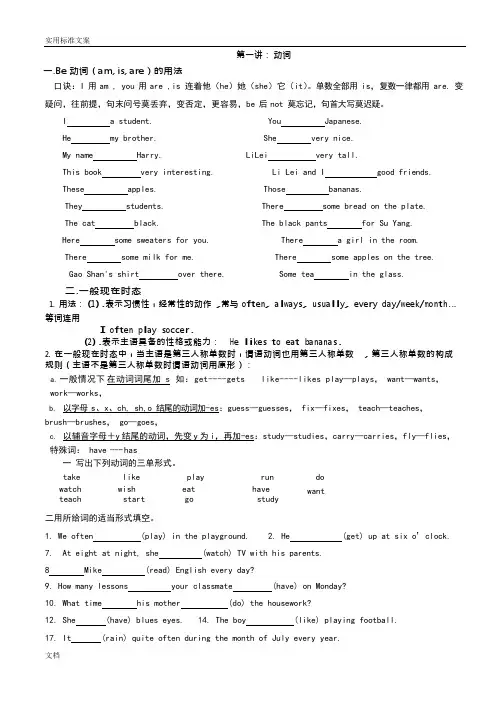
第一讲:动词一.Be 动词(am, is, are)的用法口诀:I 用 am , you 用 are ,is 连着他(he)她(she)它(it)。
单数全部用 is,复数一律都用 are. 变疑问,往前提,句末问号莫丢弃,变否定,更容易,be 后 not 莫忘记,句首大写莫迟疑。
I a student. You Japanese.He my brother. She very nice.My name Harry. LiLei very tall.This book very interesting. Li Lei and I good friends.These apples. Those bananas.They students. There some bread on the plate.The cat black. The black pants for Su Yang.Here some sweaters for you. There a girl in the room.There some milk for me. There some apples on the tree.Gao Shan's shirt over there. Some tea in the glass.二.一般现在时态1.用法:(1).表示习惯性,经常性的动作,常与o f t e n,a l w a y s,u s u a ll y,e v e r y d a y/w ee k/m o n t h…等词连用I o f t e n p l a y s o cc e r.(2).表示主语具备的性格或能力:H e li k e s t o e a t b a n a n a s.2.在一般现在时态中,当主语是第三人称单数时,谓语动词也用第三人称单数, 第三人称单数的构成规则(主语不是第三人称单数时谓语动词用原形):a.一般情况下在动词词尾加 s 如:get----gets like----likes play—plays, want—wants,work—works,b.以字母 s、x、ch, sh,o 结尾的动词加-es:guess—guesses, fix—fixes, teach—teaches,brush—brushes, go—goes,c.以辅音字母+y 结尾的动词,先变y 为i,再加-es:study—studies,carry—carries,fly—flies,特殊词: have --- has一写出下列动词的三单形式。
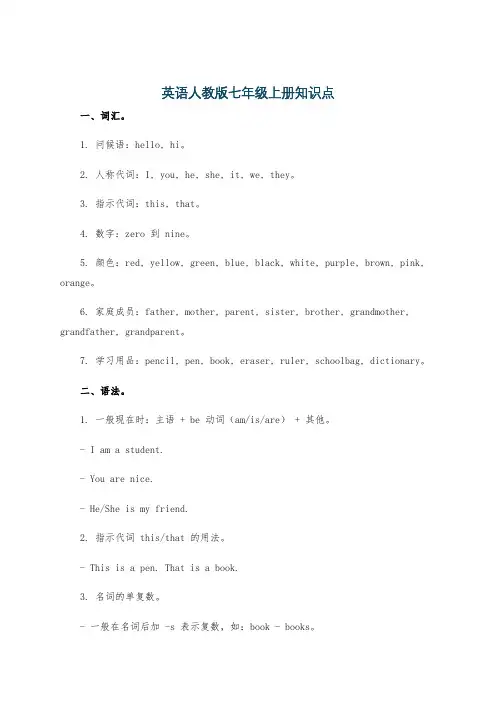
英语人教版七年级上册知识点一、词汇。
1. 问候语:hello, hi。
2. 人称代词:I, you, he, she, it, we, they。
3. 指示代词:this, that。
4. 数字:zero 到 nine。
5. 颜色:red, yellow, green, blue, black, white, purple, brown, pink, orange。
6. 家庭成员:father, mother, parent, sister, brother, grandmother, grandfather, grandparent。
7. 学习用品:pencil, pen, book, eraser, ruler, schoolbag, dictionary。
二、语法。
1. 一般现在时:主语 + be 动词(am/is/are) + 其他。
- I am a student.- You are nice.- He/She is my friend.2. 指示代词 this/that 的用法。
- This is a pen. That is a book.3. 名词的单复数。
- 一般在名词后加 -s 表示复数,如:book - books。
- 以 s, x, ch, sh 结尾的名词加 -es,如:box - boxes。
- 不规则变化,如:man - men, woman - women。
4. 形容词性物主代词。
- my(我的),your(你的/你们的),his(他的),her(她的),its(它的),our(我们的),their(他们的/她们的)三、句型。
1. 打招呼和自我介绍。
- -Hello! I'm Mary.- -Hi! My name is Tom.2. 询问物品。
- -What's this/that in English?- -It's a/an...3. 确认物品所属。
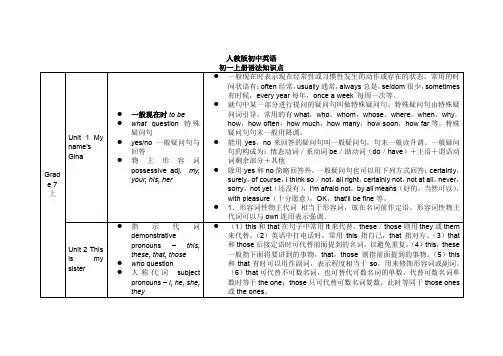

人教版七年级上册英语知识点总结人教版七年级上册英语知识1【重点单词】banana /b?'na:n?/ n. 香蕉hamburger /'h?mb?:g?/ n. 汉堡包tomato /t?'ma:t?u/ n. 西红柿ice-cream /ais'kri:m/ n. 冰激凌salad /'s?l?d/ n. 沙拉strawberry /'str?:b?ri/ n. 草莓pear /pe?/ n. 梨milk /milk/ n. 牛奶bread /bred/ n. 面包birthday /'b?:θdai/ n. 生日dinner /'din?/ n. (中午或晚上吃的)正餐week /wi:k/ n. 周;星期think about 思考;思索food /fu:d/ n. 食物sure /?u?/ adv. 当然;肯定;一定How about...? (提出建议)......怎么样? burger /'b?:g?/ n. (=hamburger)汉堡包vegetable /'ved?t?bl/ n. 蔬菜fruit /fru:t/ n. 水果right /rait/ adj. 正确的;适当的apple /'?pl/ n. 苹果then /?en/ adv. 那么egg /eg/ n. 蛋;鸡蛋carrot /'k?r?t/ n. 胡萝卜rice /rais/ n. 大米;米饭chicken /'t?ikin/ n. 鸡肉so /s?u/ conj. (引出评论或问题)那么breakfast /'brekf?st/ n. 早餐;早饭lunch /l?nt?/ n. 午餐star /sta:/ n. 明星;星星eat /i:t/ v. 吃well /wel/ adv. 好;令人满意地habit /'h?bit/ n. 习惯healthy /'helθi/ adj. 健康的really /'ri:?li/ adv. 真正地question /'kwest??n/ n. 问题want /w?nt/ v. 需要;想要be /bi:/ v. 变成fat /f?t/ adj. 肥的;肥胖的一.短语归纳1.John’s birthdaydinner 约翰的生日晚餐2.next week 下周3.think about 思考、考虑4.how about 怎么样5.some fruit 一些水果6.his birthday 他的生日7.sport star 体育明星 8.eating habits 饮食习惯9.for breakfast 作为早餐 10.for dinner 作为晚餐11.one lastquestion 最后一个问题 12.healthy food 健康的食品二.重点句型:1.have sth 吃……2.—Do you like…? 你喜欢…吗?—Yes, I do / No, I don’t. 是的,我喜欢/不,我不喜欢。
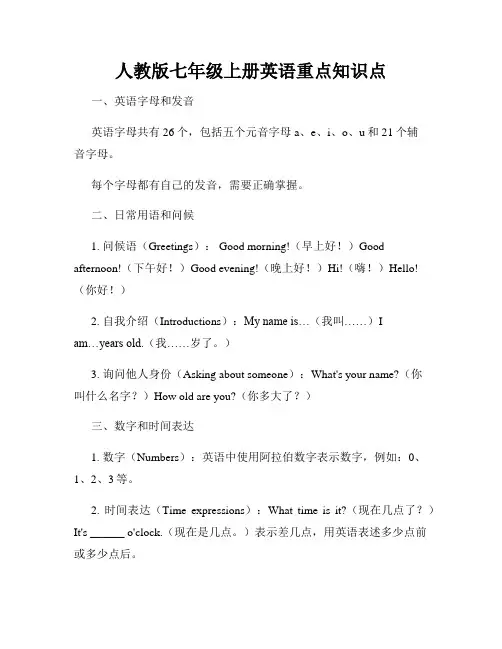
人教版七年级上册英语重点知识点一、英语字母和发音英语字母共有26个,包括五个元音字母a、e、i、o、u和21个辅音字母。
每个字母都有自己的发音,需要正确掌握。
二、日常用语和问候1. 问候语(Greetings): Good morning!(早上好!)Good afternoon!(下午好!)Good evening!(晚上好!)Hi!(嗨!)Hello!(你好!)2. 自我介绍(Introductions):My name is…(我叫……)I am…years old.(我……岁了。
)3. 询问他人身份(Asking about someone):What's your name?(你叫什么名字?)How old are you?(你多大了?)三、数字和时间表达1. 数字(Numbers):英语中使用阿拉伯数字表示数字,例如:0、1、2、3等。
2. 时间表达(Time expressions):What time is it?(现在几点了?)It's ______ o'clock.(现在是几点。
)表示差几点,用英语表述多少点前或多少点后。
四、日常用语及对话1. 询问和回答(Asking and answering):- What’s this in English?(这个用英语怎么说?)- It’s a/an _______.(这是一个……。
)2. 问路(Asking for directions):- Excuse me, where is the _______?(请问,_______在哪里?)- Go straight and turn left/right.(一直直走然后左转/右转。
)五、课堂用语及对话1. 请假(Asking for leave):- Can I go to the toilet, please?(我可以去洗手间吗?)- May I leave the classroom?(我可以离开教室吗?)2. 求救(Asking for help):- Help me, please!(请帮帮我!)- Can you help me?(你能帮助我吗?)六、家庭成员1. 父亲(Father):father/dad/daddy2. 母亲(Mother):mother/mom/mummy3. 儿子(Son):son4. 女儿(Daughter):daughter5. 兄弟(Brother):brother6. 姐妹(Sister):sister七、日常动词1. 是(be):am/is/are2. 有(have):have/has3. 去(go):go/goes4. 学习(study):study/studies5. 做(do):do/does6. 看(watch):watch/watches7. 喜欢(like):like/likes8. 在(in):in9. 玩(play):play/plays10. 坐(sit):sit/sits以上是人教版七年级上册英语的部分重点知识点,希望对你的学习有所帮助。
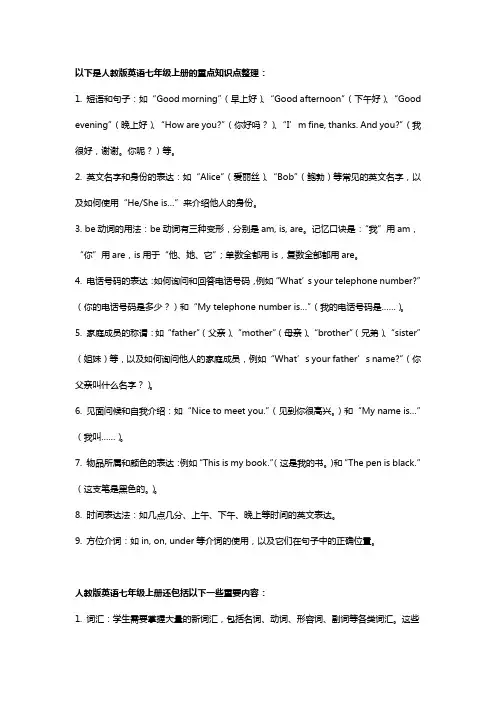
以下是人教版英语七年级上册的重点知识点整理:1. 短语和句子:如“Good morning”(早上好)、“Good afternoon”(下午好)、“Good evening”(晚上好)、“How are you?”(你好吗?)、“I’m fine, thanks. And you?”(我很好,谢谢。
你呢?)等。
2. 英文名字和身份的表达:如“Alice”(爱丽丝)、“Bob”(鲍勃)等常见的英文名字,以及如何使用“He/She is…”来介绍他人的身份。
3. be动词的用法:be动词有三种变形,分别是am, is, are。
记忆口诀是:“我”用am,“你”用are,is用于“他、她、它”;单数全都用is,复数全部都用are。
4. 电话号码的表达:如何询问和回答电话号码,例如“What’s your telephone number?”(你的电话号码是多少?)和“My telephone number is…”(我的电话号码是……)。
5. 家庭成员的称谓:如“father”(父亲)、“mother”(母亲)、“brother”(兄弟)、“sister”(姐妹)等,以及如何询问他人的家庭成员,例如“What’s your father’s name?”(你父亲叫什么名字?)。
6. 见面问候和自我介绍:如“Nice to meet you.”(见到你很高兴。
)和“My name is…”(我叫……)。
7. 物品所属和颜色的表达:例如“This is my book.”(这是我的书。
)和“The pen is black.”(这支笔是黑色的。
)。
8. 时间表达法:如几点几分、上午、下午、晚上等时间的英文表达。
9. 方位介词:如in, on, under等介词的使用,以及它们在句子中的正确位置。
人教版英语七年级上册还包括以下一些重要内容:1. 词汇:学生需要掌握大量的新词汇,包括名词、动词、形容词、副词等各类词汇。
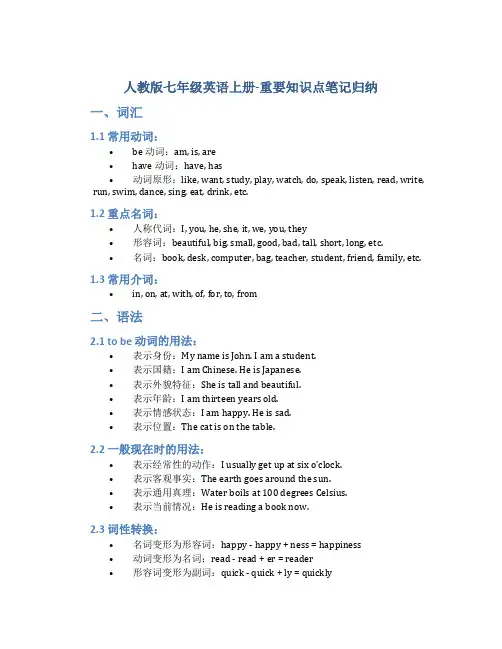
人教版七年级英语上册-重要知识点笔记归纳一、词汇1.1 常用动词:•be 动词:am, is, are•have 动词:have, has•动词原形:like, want, study, play, watch, do, speak, listen, read, write, run, swim, dance, sing, eat, drink, etc.1.2 重点名词:•人称代词:I, you, he, she, it, we, you, they•形容词:beautiful, big, small, good, bad, tall, short, long, etc.•名词:book, desk, computer, bag, teacher, student, friend, family, etc.1.3 常用介词:•in, on, at, with, of, for, to, from二、语法2.1 to be 动词的用法:•表示身份:My name is John. I am a student.•表示国籍:I am Chinese. He is Japanese.•表示外貌特征:She is tall and beautiful.•表示年龄:I am thirteen years old.•表示情感状态:I am happy. He is sad.•表示位置:The cat is on the table.2.2 一般现在时的用法:•表示经常性的动作:I usually get up at six o’clock.•表示客观事实:The earth goes around the sun.•表示通用真理:Water boils at 100 degrees Celsius.•表示当前情况:He is reading a book now.2.3 词性转换:•名词变形为形容词:happy - happy + ness = happiness•动词变形为名词:read - read + er = reader•形容词变形为副词:quick - quick + ly = quickly三、基础句型3.1 be 动词句型:•肯定句:I am a student. / He is my friend.•否定句:I am not a teacher. / She is not tall.•疑问句:Are you Chinese? / Is he a doctor?3.2 一般现在时句型:•肯定句:I usually go to school by bus.•否定句:I don’t like sports.•疑问句:Do you like pizza? / Does she speak English?3.3 祈使句:•意义:表示命令、请求、建议等。
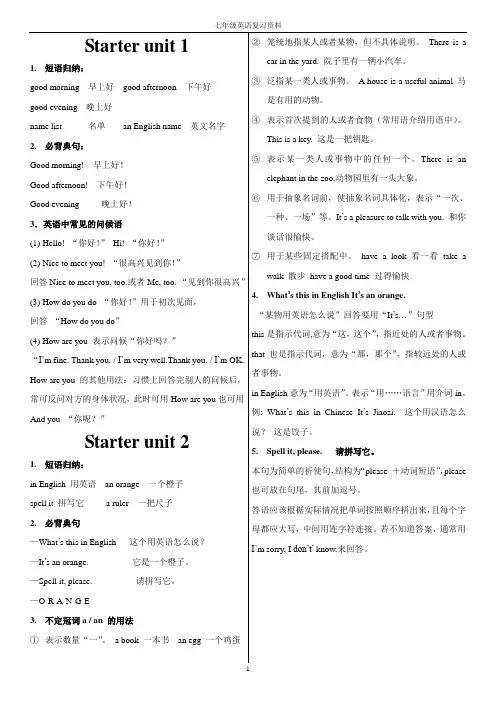
空间
form Monday to Friday 从周一到周五
form Beijing to Shanghai 从北京到上海
6.finish的用法
finish作不及物动词时,意为“完成;做好”
They start work early and finish late every day.他们每天开工早收工晚。
作及物动词,后接动词时,要用动名词形式,即finish doing sth. 表示“做完某事,
完成某事”
Jim usually finishes doing his homework before 8:00.吉姆通常在8点前做完作业。
7.thank sb for的用法:
thank sb for意为“因……而感谢某人”,for是介词,后接名词、代词或动名词,表感
谢的原因或内容。
Thank him for telling me. 谢谢他告诉我。
Thank you for helping with my English.多谢你帮我学英语。
8.for two hours的用法:
“for+一段时间”是介词短语,意为“……时间”,表示某事持续多长时间。
对其提问要用
how long
—How long will you stay in Beijing 你将在北京待多长时间?
—For about three days. 大约三天。
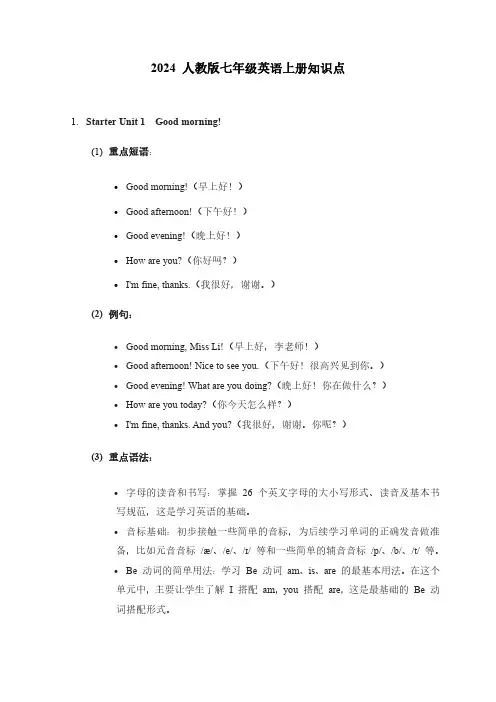
2024人教版七年级英语上册知识点1.Starter Unit1Good morning!(1)重点短语:∙Good morning!(早上好!)∙Good afternoon!(下午好!)∙Good evening!(晚上好!)∙How are you?(你好吗?)∙I'm fine,thanks.(我很好,谢谢。
)(2)例句:∙Good morning,Miss Li!(早上好,李老师!)∙Good afternoon!Nice to see you.(下午好!很高兴见到你。
)∙Good evening!What are you doing?(晚上好!你在做什么?)∙How are you today?(你今天怎么样?)∙I'm fine,thanks.And you?(我很好,谢谢。
你呢?)(3)重点语法:∙字母的读音和书写:掌握26个英文字母的大小写形式、读音及基本书写规范,这是学习英语的基础。
∙音标基础:初步接触一些简单的音标,为后续学习单词的正确发音做准备,比如元音音标/æ/、/e/、/ɪ/等和一些简单的辅音音标/p/、/b/、/t/等。
∙Be动词的简单用法:学习Be动词am、is、are的最基本用法。
在这个单元中,主要让学生了解I搭配am,you搭配are,这是最基础的Be动词搭配形式。
2.Starter Unit2What's this in English?:(1)重点单词:map(地图)cup(杯子)ruler(尺子)pen(钢笔)orange(橙子)jacket(夹克衫)key(钥匙)quilt(被子)what(什么)in(在……里)English(英语;英文)。
(2)重点短语:∙询问物品:What's this in English?(这个用英语怎么说?)、What's that inEnglish?(那个用英语怎么说?)∙回答方式:It's a/an...(它是一个……)。
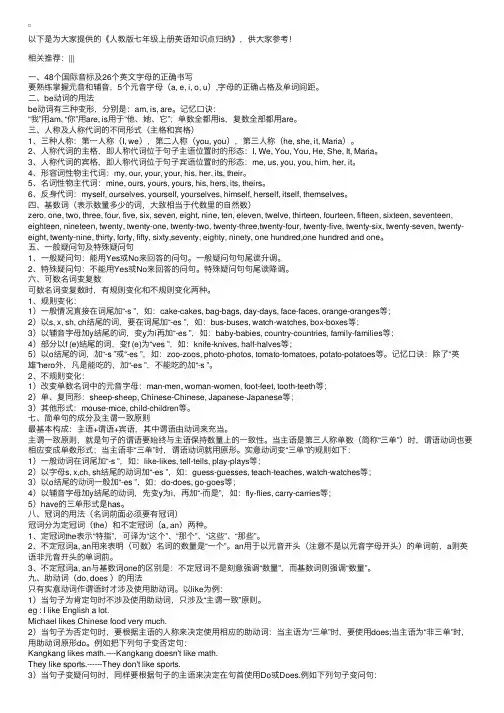
以下是为⼤家提供的《⼈教版七年级上册英语知识点归纳》,供⼤家参考!相关推荐:|||⼀、48个国际⾳标及26个英⽂字母的正确书写要熟练掌握元⾳和辅⾳,5个元⾳字母(a, e, i, o, u),字母的正确占格及单词间距。
⼆、be动词的⽤法be动词有三种变形,分别是:am, is, are。
记忆⼝诀:“我”⽤am, “你”⽤are, is⽤于“他、她、它”;单数全都⽤is,复数全部都⽤are。
三、⼈称及⼈称代词的不同形式(主格和宾格)1、三种⼈称:第⼀⼈称(I, we),第⼆⼈称(you, you),第三⼈称(he, she, it, Maria)。
2、⼈称代词的主格,即⼈称代词位于句⼦主语位置时的形态:I, We, You, You, He, She, It, Maria。
3、⼈称代词的宾格,即⼈称代词位于句⼦宾语位置时的形态:me, us, you, you, him, her, it。
4、形容词性物主代词:my, our, your, your, his, her, its, their。
5、名词性物主代词:mine, ours, yours, yours, his, hers, its, theirs。
6、反⾝代词:myself, ourselves, yourself, yourselves, himself, herself, itself, themselves。
四、基数词(表⽰数量多少的词,⼤致相当于代数⾥的⾃然数)zero, one, two, three, four, five, six, seven, eight, nine, ten, eleven, twelve, thirteen, fourteen, fifteen, sixteen, seventeen, eighteen, nineteen, twenty, twenty-one, twenty-two, twenty-three,twenty-four, twenty-five, twenty-six, twenty-seven, twenty-eight, twenty-nine, thirty, forty, fifty, sixty,seventy, eighty, ninety, one hundred,one hundred and one。

人教版七年级英语上册知识点七年级英语上册是学习英语的起点,是对基础知识的系统学习和掌握。
下面是人教版七年级英语上册的一些重要知识点。
1. 问候语和介绍在学习英语中,问候语是最基本也是最常用的表达方式之一。
常见的问候语包括:- Good morning/afternoon/evening. 早上/下午/晚上好。
- How are you? 你好吗?- I'm fine, thank you. And you? 我很好,谢谢。
你呢?- Nice to meet you. 很高兴认识你。
- Where are you from? 你来自哪里?- I'm from China. 我来自中国。
介绍自己和他人也是英语学习中非常重要的基础内容,常用的表达方式有:- My name is... 我叫...- I am... years old. 我...岁了。
- This is my friend... 这是我的朋友...- He/She is...- Nice to meet you. 很高兴认识你。
2. 数字和时间在英语中表示数字和时间的表达方式也是基础知识之一。
常用的数字包括:- 0 zero- 1 one- 2 two- 3 three- 4 four- 5 five- 6 six- 7 seven- 8 eight- 9 nine- 10 ten表达时间常用的句型有:- What time is it? 现在几点了?- It's... o'clock. 现在...点。
- What's the date today? 今天是几号?- Today is... 今天是...3. 学校生活在七年级英语上册中,学校生活也是重点内容之一。
学校生活的表达方式包括:- My school is... 我的学校是...- I study/learn... 我学习...- My favorite subject is... 我最喜欢的科目是...- I have... 我有...- My teacher is... 我的老师是...4. 家庭成员了解家庭成员也是基础知识之一。
人教版七年级上册英语知识点(必背基础打印稿)第一部分:基础知识1. 26个字母的大小写形式a...z, A...Z2. 数字0 (9)3. 常用标点符号., ? ! : ; ' "4. 问候语- 问候语:Hello, Hi, Good morning/afternoon/evening- 道别语:Bye, Goodbye, See you later 5. 介绍自己My name is ..., I'm ... years old. I'm from ... 第二部分:日常用语1. 问候与感谢- 问候:How are you? Fine, thank you. 2. 询问和回答- How do you spell it? C-A-T.- What's this in English? It's a ...3. 询问时间和时间回答- What time is it? It's ... o'clock.- What's the time? It's ... o'clock.4. 日常用语- Excuse me, Sorry, Can I help you?第三部分:语法与句型1. 动词to be- be动词的用法:am, is, are- 肯定句:I am a student.- 否定句:I'm not a teacher.- 疑问句:Are you a doctor?2. 一般现在时- 现在时动词的变化规则:第三人称单数变化规则(s/es) - 肯定句:He speaks English.- 否定句:He doesn't speak English.- 疑问句:Does he speak English?3. 名词所有格- 物主代词:my, your, his, her- 所有格的形式:用's表示;以s结尾名词加'表示;以s结尾的复数名词后加'- 例句:That's my brother's pen.4. 人称代词- 主人称:I, you, he, she, it, we, they- 宾格:me, you, him, her, it, us, them- 物主代词:my, your, his, her, its, our, their第四部分:常用句型和表达1. 常用简单句式- 主语+谓语:I am a student.- 陈述句:He plays basketball every day.- 疑问句:Do you like music?- 否定句:I do not have a pen.2. 介绍家庭成员- This is my family.- I have a father/mother/sister/brother.3. 描述人物特征和爱好- 物品颜色、大小、形状;人物身高、体重、年龄;爱好、技能、爱好。
Starter Unit1Good Morning! Units1—3【重点单词】good/gud/adj.好的morning/'mɔ:niŋ/n.早晨;上午Good morning!早上好!hi/hai/interj.(用于打招呼)嗨;喂hello/hə'ləu/interj.你好;喂afternoon/,a:ftə'nu:n/n.下午Good afternoon!下午好!evening/'i:vniŋ/n.晚上;傍晚Good evening!晚上好!how/hau/adv.怎样;如何are/a:/v.是you/ju:/pron.你;你们How are you?你好吗?I/ai/pron.我am/æm/v.是fine/fain/adj.健康的;美好的thanks/θæŋks/interj.&n.感谢;谢谢OK/əu'kei/interj.&adv.好;可以what/wɔt/pron.&adj.什么is/iz/v.是this/ðis/pron.这;这个in/in/prep.(表示使用语言、材料等)用;以English/'iŋgliʃ/n.英语adj.英格兰的;英语的in English用英语map/mæp/n.地图cup/kʌp/n.杯子ruler/'ru:lə/n.尺;直尺pen/pen/n.笔;钢笔orange/'ɔrindʒ/n.橙子jacket/'dʒækit/n.夹克衫;短上衣key/ki:/n.钥匙quilt/kwilt/n.被子;床罩it/it/pron.它a/ə/art.(用于单数可数名词前)一(人、事、物) that/ðæt/pron.那;那个spell/spel/v.用字母拼;拼写please/pli:z/interj.(用于客气地请求或吩咐)请color/'kʌlə/n.(=colour)颜色red/red/adj.&n.红色(的)yellow/'jeləu/adj.&n.黄色(的)green/gri:n/adj.&n.绿色(的)blue/blu:/adj.&n.蓝色(的)black/blæk/adj.&n.黑色(的)white/wait/adj.&n.白色(的)purple/'pə:pl/adj.&n.紫色(的)brown/braun/adj.&n.棕色(的);褐色(的)the/ði;ðə/art.指已提到或易领会到的人或事now/nau/adv.现在;目前see/si:/v.理解;明白can/kæn/modal v.能;会say/sei/v.说;讲my/mai/pron.我的知识点:1.短语归纳:good morning早上好good afternoon下午好good evening晚上好name list名单an English name英文名字2.必背典句:(1)Good morning,Alice!早上好,艾丽斯!(2)Good afternoon!下午好!(3)Hi,Bob!你好,鲍勃!(4)Hello,Frank!你好,弗兰克!(5)Good evening晚上好!(6)—How are you?你好吗?—I’m fine,thanks.How are you?我很好,谢谢。
七年级上册Unit1-7一. 考点归纳1. Hello, Gina. Good morning. 嗨,吉娜。
早上好。
英文中常用的问候语及其回答:-Hello. -Hello.―Hi. ―Hi.―Good morning. ―Good morning.―Good afternoon. ―Good afternoon.―Good evening. ―Good evening.―Good night. ―Good night.晚安。
(晚上分别时)―How do you do? 你好。
(初次见面时互相问好)―How do you do? 你好。
―How are you? 你好吗?(已相识者问对方好?)―Fine, thank you.好,谢谢。
2. Sorry, I’m late. 对不起,我迟到了。
sorry “对不起” 用于引出某一过错。
Excuse me. “对不起” 用于引起对方的注意。
例如:1)I’m sorry I can’t speak English.对不起,我不会说英语。
2)Excuse me, is this your backpack?打扰一下,这是你的背包吗?3. Nice to meet you! 很高兴认识你!--Nice to meet you, too!4. What’s this in English? 这个用英语怎么说?1) 同义句:What’s the English for this?2) 用什么语言,介词用in: “in + 某种语言”. 例如:in English 用英语in Chinese 用汉语in Japanese 用日语5. Let’s learn English. 让我们学英语。
(一)let’s = let us 让我们Let’s learn English.让我们学习英语吧。
= Why not learn English?为什么不学习英语呢?= What/How about learning English? 学习英语怎么样?为什么不:why not +do; why don’t you(二)let sb. do sth. 让某人做某事例如:Let me play the guitar.注意:1)let sb. do sth. 中的sb.若是代词要用宾格形式。
人教版七年级英语上册知识点总结归纳整理人教版七年级英语上册知识点总结归纳整理:一、基础语法知识点:1. 人称代词:主格代词、宾格代词、物主代词、反身代词等;2. 一般现在时:主谓一致、第三人称单数的变化规则、用法(谈论客观现象、习惯性动作、主语是第一人称单数时引导的问句等);3. 形容词的比较级和最高级:形容词比较级的用法、规则、形容词最高级的用法、规则;4. 简单现在进行时:用法、构成规则、特殊短语的运用;5. 一般过去时:规则动词和不规则动词的过去式变化形式、肯定、否定、一般疑问句的构成;6. 句型转换:肯定句、否定句、一般疑问句的转换等;7. 句子的基本成分:主语、谓语、宾语、表语等;8. 数词:基数词、序数词的用法;9. 形容词的位置:修饰名词的位置;10. 反意疑问句:询问对方是否同意或否定自己的说法;11. 祈使句:表示命令、请求、建议等;12. there be句型:表示某地有某物或某人;13. 介词:in、on、at的用法;14. 情态动词:can、could、may、might的用法;15. 祈使句;16. 情态动词:can、could、may、might的用法。
二、常见词组和句型:1. Greetings and Introductions问候和自我介绍(1) Hello! Hi! 你好!(2) What's your name? 你叫什么名字?(3) My name is…我叫…(4) Nice to meet you! 很高兴认识你!2. Numbers and Dates数字和日期(1) What's your telephone number? 你的电话号码是多少?(2) My telephone number is…我的电话号码是…(3) When is your birthday? 你的生日是什么时候?(4) My birthday is on…我的生日是在…3. Time时间(1) What time is it? 现在几点钟?(2) It's… o'clock. 具体时间(3) What time do you…? 你什么时候…(4) I… at…我在什么时间做…4. Class Schedule课程表(1) What's your favorite subject? 你最喜欢的科目是什么?(2) My favorite subject is…我最喜欢的科目是…(3) What time is your… class? 你…科在什么时间?(4) My… class is at…我…科在什么时间。
人教版七年级上册英语知识点系统归纳一、单词和短语1. 人称代词- 主格:I, you, he, she, it, we, they- 宾格:me, you, him, her, it, us, them2. 动词- be动词:am, is, are3. 数词- 基数词:one, two, three, four, five, six, seven, eight, nine, ten - 序数词:first, second, third, fourth, fifth, sixth, seventh, eighth, ninth, tenth4. 询问方式和回答- 询问姓名:What's your name? My name is...- 询问年龄:How old are you? I'm ... years old.- 询问国籍:Where are you from? I'm from...- 询问职业:What's your job? I'm a...- 询问日常活动:What do you do on weekends? I usually...5. 学科和科目- 数学:mathematics, math- 英语:English- 物理:physics- 化学:chemistry- 历史:history- 地理:geography- 生物:biology- 音乐:music- 美术:art- 体育:physical education, PE6. 学校设施和地点- 教室:classroom- 图书馆:library- 实验室:laboratory- 操场:playground- 餐厅:canteen- 办公室:office- 停车场:parking lot- 校门:school gate二、语法知识1. 句子结构- 主语 + 谓语:I study English.- 主语 + 谓语 + 宾语:She likes apples.- 主语 + 谓语 + 宾语 + 地点:They play basketball at the playground.- 主语 + 谓语 + 宾语 + 时间:We watch TV on weekends.- 主语 + be动词 + 表语:He is a student.2. 一般疑问句- be动词:Is she a teacher? Yes, she is. / No, she isn't.- 一般动词:Do you like sports? Yes, I do. / No, I don't.3. 物主代词- 形容词性物主代词:my, your, his, her, its, our, their- 名词性物主代词:mine, yours, his, hers, its, ours, theirs4. 形容词和副词- 形容词:big, small, tall, short, old, young, happy, sad, interesting, boring- 副词:well, badly, fast, slowly, often, sometimes, always, never5. 介词- in, on, at, under, over, beside, in front of, behind, between6. 时态- 现在时:I study English. / He likes sports.- 过去时:I studied English. / He liked sports.- 将来时:I will study English. / He will like sports.三、日常用语1. 问候语- 早上好:Good morning!- 下午好:Good afternoon!- 晚上好:Good evening!- 晚安:Good night!2. 表达喜欢和不喜欢- 喜欢:I like swimming.- 不喜欢:I don't like playing basketball.3. 请求和允许- 请求:Can I go to the restroom?- 允许:Yes, you can. / No, you can't.4. 表达时间和日期- 现在时间:It's 8 o'clock.- 日期:Today is Monday, June 1st.5. 表达感觉和状态- 感觉:I'm happy. / She is sad.- 状态:I'm hungry. / He is tired.以上是人教版七年级上册英语知识点的系统归纳,包括单词和短语、语法知识和日常用语等内容。
人教版七年级英语上册知识点汇总大全【最新整理】Starter Unit 1: Good Morning!In this unit。
we will learn some essential phrases and sentences that we use to greet people in English.1.Phrases to Know:Good morning: used to greet someone in the morningGood afternoon: used to greet someone in the afternoonGood evening: used to greet someone in the eveningName list: a list of namesAn English name: a name in English2.Sentences to Remember:Good morning。
Alice!: a greeting used in the morningGood afternoon!: a greeting used in the afternoonHi。
Bob!: a casual greetingHello。
Frank!: a formal greetingGood evening!: a greeting used in the eveningHow are you?: a common greeting used to ask someone how they are feelingI'm fine。
thanks。
How are you?: a response to the n "How are you?"I'm OK: a response to the n "How are you?"mon Greetings in English:Hello!: a casual greeting used to say "hi" or get someone's n Hi!: a more informal way to say "hello"Nice to meet you!: a polite way to greet someone when you meet them for the first timeHow do you do?: a formal greeting used when meeting someone for the first timeing Capital Letters:The first letter of the first word in a sentence should be capitalized。
第一讲:动词一.Be 动词( am, is, are)的用法口诀: I 用 am , you用 are ,is 连着他(往前提,句末问号莫丢弃,变否定,更容易,I ________ a student.He _______ my brother.My name ________Harry.This book________ very interesting.These ________ apples.They _________students.The cat________ black.Here ______ some sweaters for you.There some milk for me.Gao Shan's shirt _______ overthere.he)她( she)它( it )。
单数全部用is,复数一律都用be 后 not 莫忘记,句首大写莫迟疑。
You ________ Japanese.She_______ very nice.LiLei _________ very tall.Li Lei and I __________ good friends.Those_________ bananas.There _______ some bread on the plate.The black pants ______ for Su Yang.There ______ a girl in the room.There ______ some apples on the tree.Some tea ______ in the glass.are.变疑问,二 .一般现在时态1.用法:(1). 表示习惯性,经常性的动作, 常与often, always, usually, everyday/week/month⋯等词连用I often play soccer.(2). 表示主语具备的性格或能力:He likes to eat bananas.2.在一般现在时态中,当主语是第三人称单数时,谓语动词也用第三人称单数, 第三人称单数的构成规则(主语不是第三人称单数时谓语动词用原形):a. 一般情况下在动词词尾加b.以字母 s、 x、 ch, sh,os如:get----gets like----likes结尾的动词加-es : guess— guesses,play— plays, want— wants, work —works ,fix — fixes, teach— teaches, brush—brushes,go— goes,c. 以辅音字母+ y 结尾的动词,先变y 为 i,再加 -es : study— studies, carry — carries, fly — flies ,特殊词:have----has一写出下列动词的三单形式。
take watch teach likewishstartplayeatgorunhavestudydowant二用所给词的适当形式填空。
1. We often _________ (play) in the playground.2. He __________ (get) up at six o7.At eight at night, she_________ (watch) TV with his parents.8 _______Mike ________ (read) English every day’ clock.9.How many lessons_________ your classmate________ (have) on Monday10.What time _______his mother__________ (do) the housework12. She______ (have) blues eyes.14. The boy _________ (like) playing football.17.It _____ (rain) quite often during the month of July every year.19.Mike usually_________ (ride) a bike with his friends in the park.26.We _______ (not watch) TV on Monday.27.Sandy usually _______ (play) the piano on Sundays.28.The cat________ (like) eating fish every much.29.Su Hai and Su Yang _______ (have) eight lessons this term.30.She and I ________ (take) a walk together every evening.34.She__________ (like) fish, but she ________________ (not like) meat.第二讲:代词(一)人称代词及物主代词(默写出此表格)人称第一人称第二人称第三人称单数第一人称第二人称第三人称单数单数复数复数复数主格I you he she it we you they 我你他她它我们你们他(她、它)们宾格me you him her it us you them 我你他她它我们你们他(她、它)们形容词性物主my your his her its our your their 代词名词性物主mine yours his hers its ours yours their s代词我的你的他的她的它的我们的你们的他(她、它)们的一.主格只能作主语;宾格作宾语I (主语) am hungry, pleasegive me(宾语) something to eat.我饿了,请给我一些吃的东西。
主语 :句子要说明的人或事物The sun rises in the east.太阳从东方升起。
He likes dancing.他喜欢跳舞。
谓语 :主语的动作、状态和特征,由动词来充当.We study English. 我们学习英语2. He is asleep. 他睡着了。
宾语:动作、行为的对象.Ilike China. 我喜欢中国。
) can help me.你能帮助我。
二.形容词性物主代词修饰名词,必须放在名词前面,名词性物主代词相当于名词,后面不能再加名词用所给词的适当形式填空1.That is not _________ kite. That kite is very small, but _________ isvery big.( I )2.The dress is _________. Give it to _________. (she)3. Is this _________ watch (you) No, it’ s not.(I)________4._________ is my brother. _________ name is Jack. Look! Those stamps are _________. (he)5._________ dresses are red. (we) What color are _________ (you)6.Here are many books, which one is _________ (she)7. I can find my toy, but where ’ s (you)9. I have a beautiful cat. _________name is Mimi. These cakes are _________.(it )10. Are these _________ tickets No, _________ are not _________. _________ aren (they )’ there.11.Shall _________ have a look at that classroom That is _________ classroom. (we )12._________ is my aunt. Do you know _________ job _________ a nurse. (she )13.That is not _________ camera. _________is at home. (he )14. Where are _________ I can’ t find _________. Let’ s call(they ) parents.15.Don’ t touch _________. _________ not a cat, _________ a tiger! ( it )16._________ sister is ill. Please go and get _________. (she )17.________ don ’ t know her name. Would you please tell _________(we. )18. So many dogs. Let’ s count(they. )第三讲:名词(一)名词的分类名词包括可数名词和不可数名词,可数名词有单,复数之分,单数在前面加a/an 来表示不可数名词没有复数形式,前面也不能用a/an 来表示单数。
如:water , tea,bread ,rice, milk, money, time.ice-cream, salad, chicken( 既可作可数名词,又可作不可数名词)。
(二)可数名词复数构成规则(1)一般情况下在词尾加 s.. book—— books, dog—— dogs, pen—— pens, boy—— boys 辅音结尾的名词后的s 的读音为 [s] ,以浊辅音和元音结尾名词后的s 读音为〔 z〕。
( 2)以 s,x, ch, sh 结尾的词名词变复数时,要在词尾加es.. beach—— beaches, brush—— brushes, bus—— buses, box — boxes( es 读音为〔 iz〕( 3)以“辅音字母+y”结尾的名词,先变 y 为 i,再加 es.. city —— cities , family —— families , documentary—— documentaries, country —— countries,( 4)以 o 结尾的名词有生命的词加es 如: . tomato,potato, hero,Negro; 无生命的加s: . zoo—zoos, radio —— radios 注: zero 变复数时,既可加s,也可加es: zeros/zeroes 注:不规则变化: . man —— men, woman—— wome,, Englishman —— Englishmen, child—— children ,Chinese- Chinese, sheep-sheep,(5)另外,① 当一个名词作定语说明另一个名词时,这个名词一般用单数。